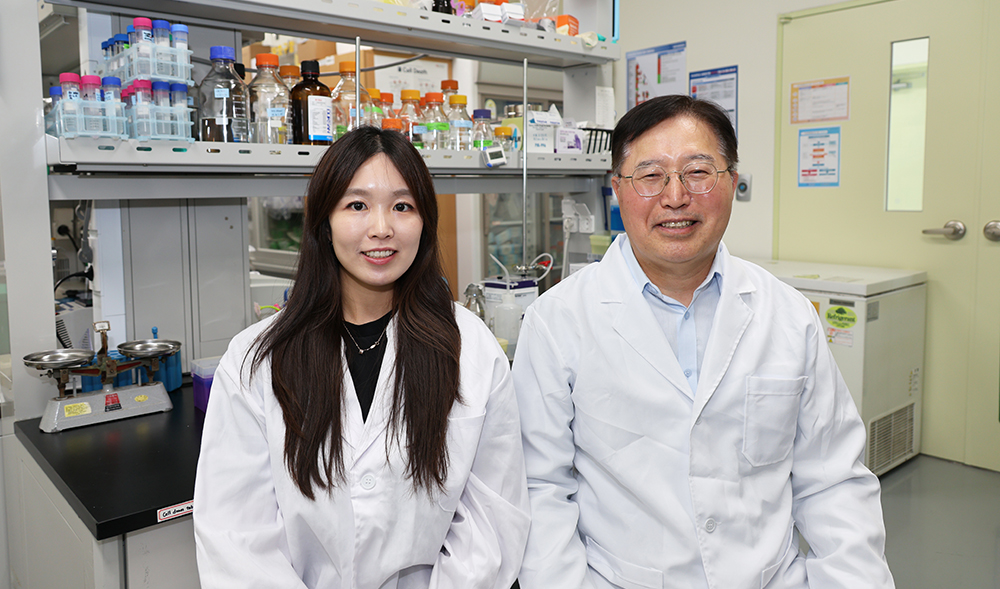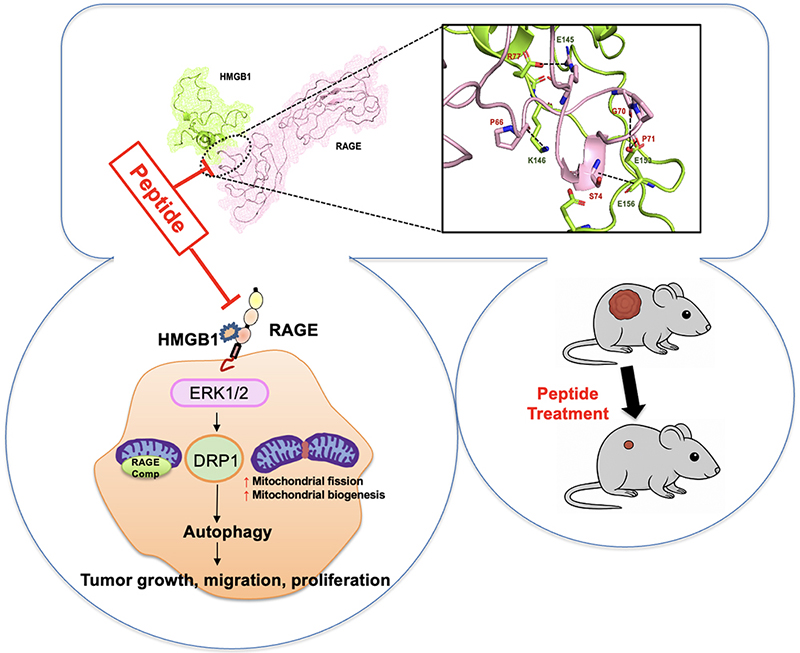
PNU 리서치
- 메인으로 이동
- 연구/산학
- PNU 리서치

분자생물학과 장세복 교수 연구팀이 암세포 생존에 관여하는 단백질 복합체의 구조를 규명하고, 이를 억제하는 펩타이드*를 개발해 암 억제 효과를 입증했다.
* 펩타이드: 단백질을 구성하는 물질인 아미노산이 2개 이상 연결된 분자로, 생물체 내에서 호르몬, 효소, 신호전달 물질 등 다양한 역할을 한다.
연구팀은 암세포 생존을 촉진하는 HMGB1(High Mobility Group Box 1)-RAGE(Receptor for Advanced Glycation End-products) 단백질 복합체의 결합 구조를 극저온 전자현미경(Cryo-EM)* 기법으로 세계 최초로 원자 수준에서 해석하고, 이 구조를 기반으로 암세포 증식·이동 억제 기능을 갖춘 펩타이드를 설계해 차세대 항암제 후보물질로서의 가능성을 제시했다.
* 극저온 전자현미경(Cryo-EM, Cryogenic Electron Microscopy): 생체 단백질을 극저온 상태에서 관찰해 원자 수준의 구조를 파악할 수 있는 최신 전자현미경.
Cryo-EM을 통해 HMGB1-RAGE 복합체의 결합 부위를 규명한 결과, HMGB1와 RAGE 간 정전기적 상호작용이 확인됐다. 이 결합을 차단하는 새로운 펩타이드는 당 독소 수용체인 RAGE와 경쟁적으로 결합해 기존 HMGB1-RAGE 복합체 형성을 저해하고, 암세포에서 활성화되는 ERK1/2(Extracellular signal-regulated kinase)–Drp1(Dynamin-related protein 1) 신호전달 경로를 억제해 자가포식(autophagy), 세포 증식 및 이동을 현저히 차단하는 것으로 나타났다.
* RAGE(Receptor for AGE): 당화 최종산물(AGEs, 당 독소)과 결합해 염증 반응을 유발하는 수용체.

【HMGB1-RAGE 복합체 구조와 펩타이드에 의한 암 억제 메커니즘】
특히 이번 연구에서는 폐암 세포주와 대장암 세포주 및 췌장암 세포주에서 펩타이드 투여 시 암세포의 ATP(아데노신 삼인산) 생성이 현저히 감소하고 세포 이동성이 억제됨을 관찰했다. 또한 정상 세포에서는 독성이 나타나지 않아 안전성 측면에서도 긍정적인 평가를 받았다.
동물실험에서도 높은 효과가 입증됐다. 면역결핍 마우스에 이식된 폐암 모델에서 펩타이드 단독 투여만으로 종양의 부피와 무게를 40% 이상 감소시켰으며, 독성은 확인되지 않았다. 정상 세포에서도 세포 독성이 나타나지 않아 안전성 확보 측면에서 유망한 결과를 보였다.
기존의 RAGE 억제제들은 비특이적 결합으로 인해 높은 부작용과 낮은 선택성이라는 한계를 갖고 있었으나, 이번 연구의 펩타이드는 복합체 결합 부위만을 정밀 저해하기 때문에 보다 표적 지향적이고 특이적인 작용기전을 구현할 수 있다는 점에서 치료제의 확장성이 매우 크다 할 수 있다.
장세복 교수는 “기존 RAGE 억제제는 낮은 특이성과 독성으로 인해 임상적 한계가 있었다”며 “이번 연구에서 제시한 펩타이드 기반 치료법은 특정 단백질 간 상호작용을 통해 암세포에 관여하는 단백질 복합체의 활동을 선택적으로 차단해 부작용을 최소화하면서 항암 효과를 극대화할 수 있는 전략”이라고 설명했다.
이번 연구성과는 생의학 분야 국제 저명 학술지인 『Biomedicine & Pharmacotherapy』 6월 1일자에 게재됐다.
- 논문 제목: Cryo-EM structure of HMGB1-RAGE complex and its inhibitory effect on lung cancer(HMGB1-RAGE 복합체의 Cryo-EM 구조와 폐암 억제 효과)
- 논문 링크: https://doi.org/10.1016/j.biopha.2025.118088
이번 연구는 과학기술정보통신부 및 교육부·한국연구재단 기초연구사업 및 개인기초연구지원사업의 지원으로 수행됐으며, 부산대 분자생물학과 장세복 교수가 교신저자, 금정제약(주) 정미숙 대표이사가 공동 교신저자, 부산대 생명시스템연구소 김현진 전임연구원이 제1저자로 참여했다. 이번 연구 결과는 국내 특허 등록된 상태다.
* 상단 연구진 사진: 오른쪽부터 장세복 교수, 김현진 전임연구원.
[Abstract]
Mitochondrial dysfunction and mitophagy are closely linked with human diseases such as neurodegenerative diseases, metabolic diseases, and cancer. High-mobility group box 1 (HMGB1) has been shown to mediate a wide range of pathological responses by binding with the receptor for advanced glycation end-products (RAGE) and toll-like receptors (TLRs). Extracellular HMGB1 and its ligand RAGE stimulate the growth, metastasis, invasiveness, and treatment resistance of different cancer cells. Through extracellular signal-regulated kinase 1/2 (ERK1/2) signaling, HMGB1 and RAGE lead to the phosphorylation of Drp1-S616 and Drp1-mediated mitochondrial fission, which consequently causes autophagy. Although the structure of the RAGE and HMGB1 complex is not clearly known, the complex has emerged as a potential therapeutic target. In the present study, the structure of the RAGE and HMGB1 complex was determined at a resolution of 5.19 Å using cryogenic electron microscopy. The structure revealed that the residues P66, G70, P71, S74, and R77 in RAGE and E145, K146, E153, and E156 in HMGB1 were the sites of interaction between the two proteins. Additionally, an HMGB1 peptide (151 LKEKYEK 157) was synthesized based on the RAGE-HMGB1 complex. We investigated the inhibitory function of the HMGB1 peptide and demonstrated that it inhibits tumor growth, metastasis, and invasion by binding to the RAGE protein in lung cancers. The HMGB1 peptide significantly suppressed mitochondrial dysfunction and the initiation of autophagy. Furthermore, the HMGB1 peptide dramatically reduced cell viability, migration, and mitophagy in the colorectal and pancreatic cancer cell lines HCT-116 and AsPC-1, respectively.
- Authors (Pusan National University): Hyeon Jin Kim (Insitute of Systems Biology), Mi Suk Jeong (Insitute of Systems Biology), Se Bok Jang (Department of Molecular Biology)
- Title of original paper: Cryo-EM structure of HMGB1-RAGE complex and its inhibitory effect on lung cancer
- Journal: Biomedicine & Pharmacotherapy
- Web link: https://doi.org/10.1016/j.biopha.2025.118088
- Contact e-mail: sbjang@pusan.ac.kr
